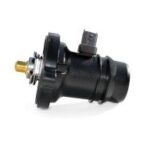Car battery corrosion is a common issue that many vehicle owners encounter. It’s that powdery, often bluish-white substance that accumulates on battery terminals. While seemingly minor, battery corrosion can lead to significant problems if left unaddressed, affecting your car’s starting power and overall electrical system performance. Understanding the root causes of this corrosion is the first step in preventing and resolving it.
The primary culprit behind battery corrosion is a chemical reaction. Car batteries contain sulfuric acid as an electrolyte. Through vents in the battery cap, hydrogen gas is released as a byproduct of the battery’s normal charging and discharging cycles. When this hydrogen gas escapes and comes into contact with the air around the battery terminals, it interacts with oxygen and other substances present in the engine compartment’s atmosphere. This mixture, combined with moisture and other contaminants, initiates a chemical reaction that results in the formation of corrosion on the metal terminals, typically made of lead.
Interestingly, the location of corrosion can sometimes indicate potential issues within your car’s charging system. Corrosion predominantly on the negative terminal often suggests an undercharging system. In this scenario, the battery isn’t receiving sufficient charge, potentially leading to sulfation and increased hydrogen gas release from the negative terminal area. Conversely, if corrosion is more pronounced on the positive terminal, it might point towards an overcharging system. Overcharging can cause excessive gassing, forcing more electrolyte vapor out and leading to corrosion around the positive terminal. However, it’s crucial to note that corrosion can appear on either terminal and is not solely definitive of charging system problems. Environmental factors, the age of the battery, and even driving conditions can influence where corrosion is more noticeable.
To effectively combat battery corrosion, regular cleaning is essential. A simple and effective method involves using a baking soda and water solution. Before you begin cleaning, ensure your safety by wearing eye protection, gloves (nitrile gloves are recommended for their chemical resistance), and old clothes, as battery acid can be corrosive and damaging.
To clean the corrosion, first, disconnect the battery cables, starting with the negative terminal. Prepare a solution of baking soda and water. Apply this solution to the corroded terminals using a stiff brush (a non-metallic brush is preferable to avoid sparks). The baking soda will neutralize the battery acid and help loosen the corrosion. Thoroughly scrub the terminals and cable clamps to remove all traces of corrosion. Once cleaned, rinse the area with clean water to eliminate any baking soda residue, as leftover residue can also cause issues over time. Make sure the area is dried properly after rinsing.
After cleaning and drying the terminals, taking preventative measures is key to slowing down future corrosion. Applying a thin layer of grease to the battery terminals is a widely recommended practice. High-pressure grease or wheel bearing grease works effectively by creating a barrier against air and moisture. Coat the terminals completely with grease after reconnecting the battery cables. You can also use commercially available battery terminal protector sprays, which serve the same purpose of creating a protective coating.
The goal is to prevent the lead terminals from being exposed to hydrogen gas and oxygen, thus hindering the chemical reaction that causes corrosion. Keep in mind that grease or protective sprays are not permanent solutions. Over time, the protective layer can degrade, and corrosion might reappear. Therefore, regular inspection and cleaning, ideally every six months or during routine car maintenance, are crucial for maintaining a healthy battery and preventing corrosion-related problems. By understanding What Causes Battery Corrosion In A Car and implementing these preventative and maintenance steps, you can ensure your car’s battery system remains reliable and efficient.
